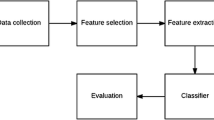Abstract
Hip fracture caused by falls and its complications is one of the greatest threats to disability and death of the elderly. To reduce physical damage from falls in the elderly, the current solution to achieve effective protection is detecting fall trends and turning on protective devices. However, the existing products have the problems of low accuracy and poor real-time. In this paper, a high accuracy and high real-time human fall detection and protection system based on characteristic areas algorithm is designed, which can detect the trend of falls within 400 ms after the human body begins to fall and is filled with the airbag in the 400 ms later, realizing effective protection of the human hip. The system got 95.33% accuracy, with an average airbag opening time of 70 ms.
Access this chapter
Tax calculation will be finalised at checkout
Purchases are for personal use only
Similar content being viewed by others
References
Jiang, J., Long, J., Ling, W., et al.: Incidence of fall-related injury among old people in mainland China. Arch. Gerontol. Geriatr. 61(2), 131–139 (2015)
Hu, L.: Fall detection algorithms based on wearable device: a review. J. Zhejiang Univ. (Eng. Sci.) 52(9), 1717–1728 (2018)
Ahn, S., Shin, I., Kim, Y.: Pre-impact fall detection using an inertial sensor unit. J. Foot Ankle Res. 7(1), A124 (2014)
Lee, J.K., Robinovitch, S.N., Park, E.J.: Inertial sensing-based pre-impact detection of falls involving near-fall scenarios. IEEE Trans. Neural Syst. Rehabil. Eng. 23(2), 258–266 (2015)
Otanasap, N.: Pre-impact fall detection based on wearable device using dynamic threshold model. In: 17th International Conference on Parallel and Distributed Computing, Applications and Technologies (PDCAT), pp. 362–365. IEEE Computer Society (2016)
Aziz, O., Russell, C.M., Park, E.J., et al.: The effect of window size and lead time on pre-impact fall detection accuracy using support vector machine analysis of waist mounted inertial sensor data. In: Proceedings of International Conference on Engineering in Medicine and Biology Society, pp. 30–33. IEEE, Chicago (2014)
Diep, N.N., Pham, C., Phuong, T.M.: A classifier-based approach to real-time fall detection using low-cost wearable sensors. In: Proceedings of the Fifth Symposium on Information and Communication Technology, pp. 14–20. IEEE, Hanoi (2014)
Er, J.K., Ang, W.T.: Evaluation of single HMM as a pre-impact fall detector based on different input signals. In: 2018 IEEE Region Ten Symposium (Tensymp), Sydney, Australia, pp. 207–212 (2018)
Jian, H., Chen, H.: A portable fall detection and alerting system based on k-NN algorithm and remote medicine. Communications 12(4), 23–31 (2015)
Khan, S.S., Karg, M.E., Kulić, D., Hoey, J.: X-factor HMMs for detecting falls in the absence of fall-specific training data. In: Pecchia, L., Chen, L.L., Nugent, C., Bravo, J. (eds.) IWAAL 2014. LNCS, vol. 8868, pp. 1–9. Springer, Cham (2014). https://doi.org/10.1007/978-3-319-13105-4_1
Nukala, B.T., Shibuya, N., Rodriguez, A.I., et al.: A real-time robust fall detection system using a wireless gait analysis sensor and an artificial neural network. In: Proceedings of International Conference on Healthcare Innovation, pp. 219–222. IEEE, Seattle (2014)
Fakhrulddin, A.H., Fei, X., Li, H.: Convolutional neural networks (CNN) based human fall detection on body sensor networks (BSN) sensor data. In: 4th International Conference on Systems and Informatics (ICSAI), Hangzhou, pp. 1461–1465 (2017)
Münzner, S., Schmidt, P., Reiss, A., et al.: CNN-based sensor fusion techniques for multimodal human activity recognition. In: Proceedings of the 2017 ACM International Symposium on Wearable Computers, pp. 158–165 (2017)
Shi, G., Chan, C.S., Luo, Y., et al.: Development of a human airbag system for falling protection using MEMS motion sensing technology. In: IEEE/RSJ International Conference on Intelligent Robots and Systems, pp. 4405–4410. IEEE (2006)
Toshiyo, T., Masaki, S., Takumi, Y.: A wearable airbag to prevent fall injuries. IEEE Trans. Inf. Technol. Biomed. 13(6), 910–914 (2009)
Toshiyo, T., Takumi, Y., Masaki, S.: A preliminary study to demonstrate the use of an air bag device to prevent fall-related injuries. In: Proceedings of the 29th Annual International Conference of the IEEE EMBS Cité Internationale, Lyon, France, pp. 23–26. IEEE (2007)
Yilun, L., Guangyi, S., Josh, L., et al.: Towards a human airbag system using µIMU with SVM training for falling-motion recognition. In: IEEE International Conference on Robotics and Biomimetics (IEEE ROBIO), Hong Kong. IEEE (2009)
Zeng, M., Nguyen, L.T., Yu, B., et al.: Convolutional neural networks for human activity recognition using mobile sensors. In: Sixth International Conference on Mobile Computing, Applications and Services (MobiCASE 2014), pp.197–205. IEEE (2014)
Zhong, Z., Chen, F., Zhai, Q., et al.: A real-time pre-impact fall detection and protection system. In: IEEE/ASME International Conference on Advanced Intelligent Mechatronics (AIM), pp. 1039–1044. IEEE (2018)
Guangyi, S., Cheung-Shing, C., Guanglie, Z.: Towards a mobile airbag system using MEMS Sensors and embedded intelligence. In: IEEE International Conference on Robotics and Biomimetics (ROBIO), Sanya, China, pp. 634–639. IEEE (2007)
Xu, T., Se, H., Liu, J.: A fusion fall detection algorithm combining threshold-based method and convolutional neural network. Microprocess. Microsyst. 82, 103828 (2021)
Hassan, M.M., et al.: A smartphone-enabled fall detection framework for elderly people in connected home healthcare. IEEE Netw. 33(6), 58–63 (2019)
Acknowledgment
This research was funded by the National Key R&D Program of China (2018YFB1307002) and Beijing Municipal Science and Technology Project (Z191100004419008).
Author information
Authors and Affiliations
Corresponding author
Editor information
Editors and Affiliations
Rights and permissions
Copyright information
© 2021 Springer Nature Switzerland AG
About this paper
Cite this paper
Du, J., Shi, J., Wei, X., Xu, Y., Chen, D. (2021). Fall Detection and Protection System Based on Characteristic Areas Algorithm. In: Liu, XJ., Nie, Z., Yu, J., Xie, F., Song, R. (eds) Intelligent Robotics and Applications. ICIRA 2021. Lecture Notes in Computer Science(), vol 13013. Springer, Cham. https://doi.org/10.1007/978-3-030-89095-7_17
Download citation
DOI: https://doi.org/10.1007/978-3-030-89095-7_17
Published:
Publisher Name: Springer, Cham
Print ISBN: 978-3-030-89094-0
Online ISBN: 978-3-030-89095-7
eBook Packages: Computer ScienceComputer Science (R0)




